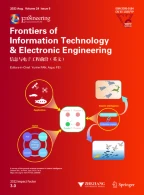Abstract
The component-based business architecture integration of military information systems is a popular research topic in the field of military operational research. Identifying enterprise-level business components is an important issue in business architecture integration. Currently used methodologies for business component identification tend to focus on software-level business components, and ignore such enterprise concerns in business architectures as organizations and resources. Moreover, approaches to enterprise-level business component identification have proven laborious. In this study, we propose a novel approach to enterprise-level business component identification by considering overall cohesion, coupling, granularity, maintainability, and reusability. We first define and formulate enterprise-level business components based on the component business model and the Department of Defense Architecture Framework (DoDAF) models. To quantify the indices of business components, we formulate a create, read, update, and delete (CRUD) matrix and use six metrics as criteria. We then formulate business component identification as a multi-objective optimization problem and solve it by a novel meta-heuristic optimization algorithm called the ‘simulated annealing hybrid genetic algorithm (SHGA)’. Case studies showed that our approach is more practical and efficient for enterprise-level business component identification than prevalent approaches.
Similar content being viewed by others
References
Arch-int, S., Batanov, D.N., 2003. Development of industrial information systems on the web using business components. Comput. Ind., 50(2):231–250. https://doi.org/10.1016/s0166-3615(02)00122-7
Bui, T.N., Moon, B.R., 1996. Genetic algorithm and graph partitioning. IEEE Trans. Comput., 45(7):841–855. https://doi.org/10.1109/12.508322
Cai, Z.G., Yang, X.H., Wang, X.Y., et al., 2011. A fuzzy formal concept analysis based approach for business component identification. J. Zhejiang Univ.-Sci. C (Comput. & Electron.), 12(9):707–720. https://doi.org/10.1631/jzus.c1000337
DoDAF Development Team, 2010. UPDM Search and Rescue (SAR) Diagrams and DoDAF 2 Markups. http://dodcio.defense.gov/Library/DoD-Architecture- Framework/dodaf20journal/
DoD Architecture Framework Working Group, 2009. DoD Architecture Framework Version 2.0, Volume 1: Introduction, Overview, and Concepts, Manager’s Guide. Department of Defense, USA. http://www.doc88.com/p-3774254078745.html
Fu, J., Luo, A.M., Luo, X.S., et al., 2016. A component business model-based approach for business architecture integration of C4ISR system. Int. Conf. on Information Science and Control Engineering, p.17–21. https://doi.org/10.1109/icisce.2016.15
Ganesan, R., Sengupta, S., 2001. O2BC: a technique for the design of component-based applications. 39th Int. Conf. and Exhibition on Technology of Object-Oriented Languages and Systems, p.46–55. https://doi.org/10.1109/TOOLS.2001.941658
Goldberg, D.E., 1989. Genetic Algorithms in Search, Optimization and Machine Learning. Addison-Wesley, Boston, USA.
IBM Business Consulting Services, 2006. Component Business Models Making Specialization Real. http://ptgmedia.pearsoncmg.com/imprint_downloads/ informit/pdfs/cbm.pdf
Jain, H., Chalimeda, N., Ivaturi, N., et al., 2001. Business component identification—a formal approach. IEEE Int. Conf. on Enterprise Distributed Object Computing, p.183–187. https://doi.org/10.1109/edoc.2001.950437
Jamshidi, P., Mansour, S., Sedighiani, K., et al., 2012. An Automated Service Identification Method. Technical Report No. 1, TR-ASER-2012-01, Automated Software Engineering Research Group, Shahid Beheshti University, Iran.
Kirkpatrick, S., Gelatt, C.D., Vecchi, M.P., 1983. Optimization by simulated annealing. Science, 220(4598):671–680. https://doi.org/10.1126/science.220.4598.671
Lee, J.K., Jung, S.J., Kim, S.D., et al., 2001. Component identification method with coupling and cohesion. 8th Asia-Pacific Software Engineering Conf., p.79–86. https://doi.org/10.1109/apsec.2001.991462
Lee, S.D., Yang, Y.J., Cho, E.S., et al., 1999. COMO: a UML-based component development methodology. Software Engineering Conf., p.54–61. https://doi.org/10.1109/APSEC.1999.809584
Levi, K., Arsanjani, A., 2002. A goal-driven approach to enterprise component identification and specification. Commun. ACM, 45(10):45–52. https://doi.org/10.1145/570907.570930
Maritime and Coastguard Agency, 2008. Search and Rescue Framework for the United Kingdom of Great Britain and Northern Ireland. https://www.gov.uk/government/publications/searchand- rescue-framework-uksar
Meng, F.C., Zhan, D.C., Xu, X.F., 2005. Business component identification of enterprise information system: a hierarchical clustering method. IEEE Int. Conf. on E-Business Engineering, p.473–480. https://doi.org/10.1109/icebe.2005.32
Qin, Z., Liang, Y., Zou, H., 2003. Study on identification method of business process based on CIMOSA. J. Manag. Sci. China, 6(3):13–18 (in Chinese).
Scheer, A.W., 2000. ARIS—Business Process Modeling. Springer-Verlag Berlin Heidelberg. https://doi.org/10.1007/978-3-642-57108-4
Wang, Z.J., Xu, X.F., Zhan, D.C., 2006. A survey of business component identification methods and related techniques. Int. J. Inform. Technol., 2(4):229–238.
Yang, Y., Wang, J.F., Song, X.F., et al., 2002. Business system planning based on BPR. Comput. Eng. Appl., 22:220–223 (in Chinese).
Yuan, X.W., Qin, Z., 2009. A decoupling approach to business component identification. 2nd Int. Symp. on Information Science and Engineering, p.467–471. https://doi.org/10.1109/ISISE.2009.40
Author information
Authors and Affiliations
Corresponding author
Additional information
Project supported by the National Natural Science Foundation of China (No. 71571189)
Rights and permissions
About this article
Cite this article
Fu, J., Luo, Xs., Luo, Am. et al. Enterprise-level business component identification in business architecture integration. Frontiers Inf Technol Electronic Eng 18, 1320–1335 (2017). https://doi.org/10.1631/FITEE.1601836
Received:
Accepted:
Published:
Issue Date:
DOI: https://doi.org/10.1631/FITEE.1601836
Key words
- Business architecture integration
- Business component
- Component identification
- Create, read, update, and delete (CRUD) matrix
- Heuristic
